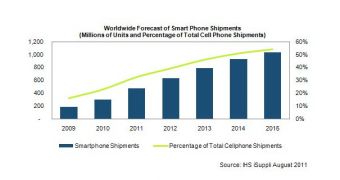Smartphones are already highly popular among mobile phone users today, but it seems that they will become even more popular in the coming years, at least this is what a recent report from iSuppli shows.
More than half of the mobile phone market in 2015 will encompass smartphones, the IHS iSuppli Mobile Handset Market Tracker report unveiled.
The analyst firm expects for smartphone unit shipments to grow to 1.03 billion units in 2015, which would be more than double when compared to the 478 million they would reach in 2011.
The share of smartphones should increase to up to 54.4 percent of the total mobile market in 2015, up from the 32.5 percent they are expected to account for in 2011.
When taking into consideration the fact that smartphones accounted for only 15.8 percent of the total cellphone market in 2009, the growth seems even more impressive.
In the smartphone segment, low-end models are expected to experience the highest growth, the research firm notes.
Shipments of these low-end smartphones should grow to a compound annual growth rate of 115.4 percent between 2010 and 2015, while mid-range to high-end smartphones will enjoy a CAGR of only 16.4 percent .
“With their affordable prices, low-end smart phones are attractive to first-time users and to consumers in emerging economies where subscriber levels are rising at the fastest rates of all regions of the world, such as China, India, South Asia and Africa,” said Francis Sideco, senior principal analyst, wireless communications for IHS.
“Low-end smart phones often are sold with inexpensive tiered data plans that target consumers who do not yet need full-featured services. This further reduces these phones’ total cost of ownership, making them attractive to vast numbers of entry-level consumers.”
Some mobile phone makers will see impressive growth as well, courtesy of these low-end devices, which will appeal a lot to customers in China and Latin America.
Samsung, for example, will enjoy significant growth due to an appealing lineup of affordable devices. The company already posted a 600 percent sequential increase in shipments in Q2 2011.
The increase registered in the mobile application development field will also result in growth on the smartphone area.
“Success in the mobile phone industry is no longer purely a function of hardware capabilities,” Sideco said. “Growth for all players is being determined by a number of other important factors, such as software capabilities, the sleekness and intuitiveness of the user interface and the availability of a variety of applications.”

 14 DAY TRIAL //
14 DAY TRIAL //